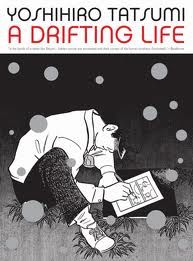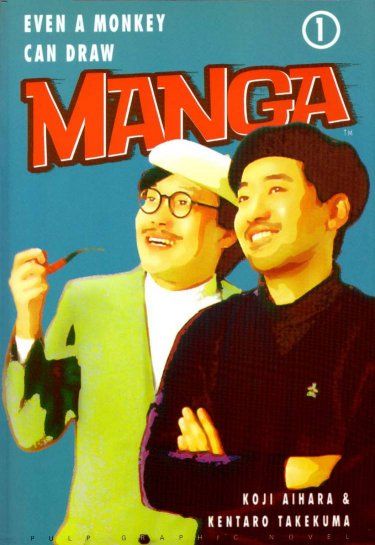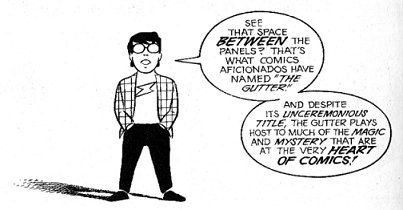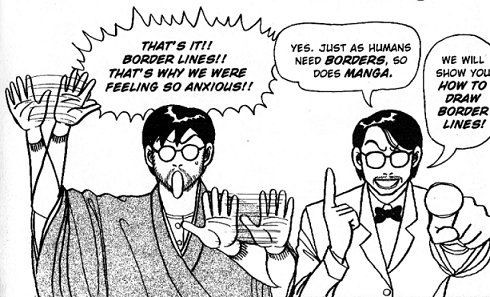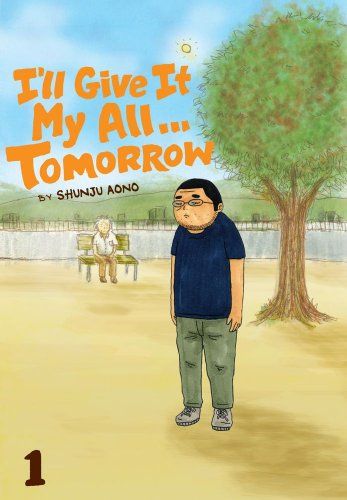Say what you will about meta entertainment, but I've always had a soft spot for it. There's something exciting to me about reading a behind-the-scenes look, especially one that was made for the sake of entertainment. There are many manga series about making manga, and they run the range from awful to amazing, nonfiction to "fictionalized" accounts. I've already touched on Bakuman, which is a surprisingly exciting series that puts Shounen Jump manga under a microscope. There's a handful of others, but here's three more of the best, in my opinion.
A Drifting Life - Yoshihiro Tatsumi (1 volume)
This is a massive, 800+ page brick of a volume about the early history of manga and the underground manga movement that was headed by Tatsumi, among others. It's part history lesson and part autobiography, with Tatsumi using his life to tell the history of manga as he saw it. We get details about Tatsumi and his brother reading early and very inspirational Tezuka volumes in their childhood. We learn how both Tatsumi and his brother got their start by submitting stories to the booming postwar manga periodical business, and how from there they found themselves being commissioned to draw their own volumes, sometimes of other people's stories, sometimes their own. Tatsumi was better at narrative, whereas his brother was better at gag, humor, and children's comics. Tatsumi also includes a lot of details about current pop culture trends, what movies were out and how they were influencing the artists and stories at the time, and how the news was reflected in the fiction. As someone interested in the genre, this is really the best source in English for this information. In addition to the history aspect, there's also a lot of firsthand accounts of other artists, since Tatsumi meets and grows up with several of the big names in early manga. In addition to Tezuka, he works closely with Takao Saito in Tokyo, the mangaka who went on to draw Golgo 13 after reading Mickey Spillane. Tatsumi also either includes or mimics the styles of the manga at the time, and it's extremely interesting to see the dominant styles, both his and others, morph as the years go on. It's long, and includes a lot of detail that might not appeal to those not interested in the subject, but for me, this was a wonderful book, and the only bad part was when it stopped in the 60s. This is in print and available.
Even a Monkey Can Draw Manga - Koji Aihara & Kentaro Takekuma (1 volume)
This may be harder to appreciate if you haven't read a lot of manga, but Even a Monkey Can Draw Manga is one of the funniest/creepiest volumes of manga out there. Each of the short chapters features some aspect of drawing and making manga, introduced in one page by Koji Aihara and Kentaro Takekuma, then taken over by a fictional writer/artist team. Some chapters are about figure drawing or choosing a pen name, some are about panel layout, many others are about particular genres of manga, several are about Japanese manga magazines. The first time I read this, I thought it was an over-the-top parody of the manga creation process, but when I re-read it recently, it actually sounds like they're offering genuine advice and several real examples of both good and bad work. Usually, the fictional artist makes several bad and/or stupid suggestions about the topic at hand, and the writer berates him and offers advice based on what's popular, which is often just as ridiculous (but still true). For instance, when discussing how to choose a pen name, the writer makes several concrete rules, and then reveals lists of very real pen names submitted to a publishing company over the years. In one chapter, when discussing what makes a popular plot, a ridiculous story discussed at length is actually the plot to the Kazuo Koike series Offered. I can't tell if the advice is sincere or offered for the sake of humor, but all of it is 100% backed up by real examples. They also offer some history lessons, like the true history of panty art in manga. One of my favorite parts is when they compare the styles of the 4 main boys' comic magazines by explaining how the story of Momotaro would be told in each. The creepy part of this book is how predictive and relatively modern this advice is. This was made from 1986-88 and translated into English in 2000, and most everything in there is still good, even in terms of the genre story tips. One particular bit of frightening accuracy comes when they suggest that ninjas will be the next big thing in boys' comics a decade before Naruto made it big. For whatever reason, sometimes their arguments are punctuated by naked (censored) photos of the authors. It's a bizarre book, but it's like the more foul and sarcastic manga cousin of Understanding Comics. Scarily so. They were contemporary books, or I would almost suspect an influence.
There is a second volume of this that was tragically not translated into English, but without an ongoing story, you're not really missing it. More tragically, the English volume is way out-of-print and experiences serious price fluctuation in online marketplaces. Right now the cheapest copy is over $20, but I waited and got mine for less than $10. I also recently saw a new copy in a comic store in the area. Keep an eye out.
I'll Give It My All... Tomorrow - Shunju Aono (5+ volumes)
Shizuo is an average 40-something man that simply tires of his office job one day, and decides to give it all up to chase his dream of becoming a manga artist. Actually, he quits his job, and fits the idea of becoming a manga artist in after the fact. This dream is the one thing that Shizuo sticks to throughout the series. While Shizuo does draw manga stories, he's not a good artist, and doesn't know anything about manga. He does win a newcomer prize with one of his first stories, and is assigned an editor at a publisher, but the editor frequently doesn't have much to say about Shizuo's work, and he is rejected 90% of the time. But that's okay, because Shizuo doesn't work that hard anyway. He frequently finds himself in "slumps," which basically means he's doing everything but drawing, hence the title of the story. Most of his stories are drawn in one shot while riding out a flash of inspiration, but they also very often read like a fantasy version of Shizuo's life, set to whatever genre he's chosen at the time. Eventually, Shizuo's father and daughter get tired of supporting him when he can't sell a single story, and he gets a job as a fast food cook. This series is kind of amazing for being both perversely inspirational and horribly depressing. Shizuo isn't trying very hard to improve or become a manga artist, and he's very lazy. All the same, you can't help but root for him and get behind his dream. And sometimes, his stories are kind of awesome, in their own bizarre way. But most of the time, Shizuo's failures paint a grim picture, and his relationships with his father and daughter come under a lot of strain. Later, he finds himself offering advice to his teenage co-workers and more successful friends. It's a strange, meandering series, and I'm not sure if it's actually going anywhere, but it's strangely addictive. It's also worth mentioning that... the art in this series is intentionally (?) badly-drawn and flat, and that the author biography reads something like Shizuo's resume, except Aono landed a series. Make of that what you will. All the volumes of this are currently in print and available.


